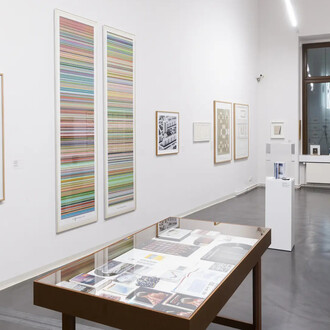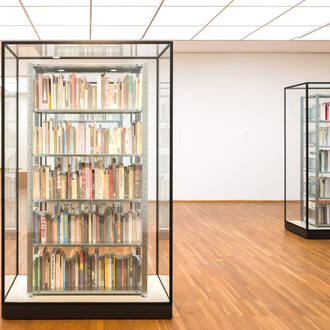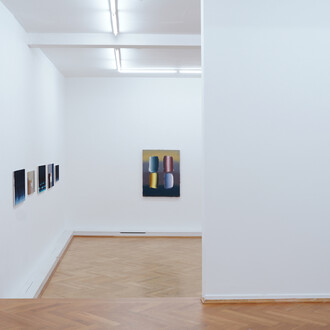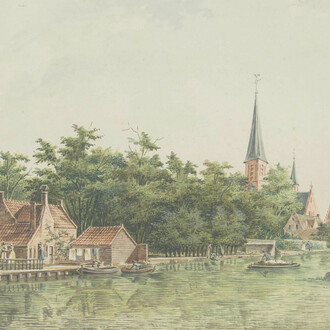There are flavors that carve themselves into memory; the tart sweetness, for example, of blood orange juice, drunk one summer morning in 2017 before the day raises its demands. A hot summer filled with cartoons, cornflakes, boredom, computer games in the shadowed room, and not least this flavor of the blood orange. There was time aplenty, for idling in the best sense, a time between completion and fresh departure, between after and before.
Aelita le Quément paints from out of this in-between time. Her pictures tell stories of people sitting, somehow, on the edge of something: the street, decision, their own story. Nothing is static in le Quément’s world, everything is in motion, in transition. Places of passage, gas stations, waiting rooms, kiosks become sceneries of existence in which, as though incidentally, we encounter ourselves.
Yet before le Quément could tell her stories, she needed to chart a different way to expression. She grew up a quiet child, in a body whose language she did not know; an early diagnosis of dysphasia, a neurological speech development disorder, turned words into obstacles. Communication became a construction project, sentence by sentence, syllable by syllable. In this silent in-between time, drawing offered a bridge; illustration, a language. If the tongue could not say it, the hand narrated it. What started out as a therapeutic necessity became a creative path. The line evolved into form; the dash, into feeling. In school, when questions of identity became more pressing, drawing offered a place of refuge; a nest, a shelter, a quiet control room. Aelita le Quément—this was not yet her name—began envisioning herself.
She grew up in a milieu that was liberal but not knowledgeable. Queerness, being trans, feeling different: for the longest time, all these remained nameless. It was only with films like Paris is burning, with new friendships, romantic affairs, and the conversations they brought about what it means to be human and, yes, flawed, that she embarked on the process of becoming herself. A story of silence became one of speech, not only in words, but in pictures. It was around this time that she understood something fundamental—that people inflicted pain not because they were bad but because they had suffered pain themselves. That imperfection was not a defect but a necessary trace of humanness. This insight would mark a turning point, the decision to make peace with the past and to choose a new name for herself. »Aelita« becomes the figure of self-empowerment, the gesture of control over her own life.
The exhibition Blutorange is steeped in this movement that is both personal and collective, the movement of a quest, an expectation, and of an encounter, an anticipation fulfilled. Two rooms structure the narrative, two landscapes of the soul, two directions of the gaze: the outward gaze and the inward one.
The first room, Gas station, takes a look at the outside world; at being on the way, at the in-between, alien places, places on the divide, liminal spaces. Le Quément transmutes functional locales into social stage sets. A gas station here becomes a temporary home; a meeting spot after the shift, before the club, between the now and the after; its purpose is not the nominal one, refueling, but its defamiliarization, togetherness, existence in a community. The large-format paintings show exterior and interior spaces that interpenetrate: product shelves filled with everyday articles, neon light on skin, exchanges in passing and in passage. To enter this room is to straddle the divide oneself, to be in transit, in the transition of spaces, in the in-between, to partake of the sceneries of the works. The paintings in large formats constitute its centerpiece: a triptych of holding out.
In the room Cartoons and cereals, the gaze turns introspective, the memory of the child’s room, of the flickering television set, the static of cartoons on the screen, and the world waiting outside. Inward life, childhood, loss, transformation, recollections of French animes and bowls of cornflakes in the mornings become vehicles of a melancholy that shrouds the horizon. The soft shapes reminiscent of Looney Tunes characters, the bright colors may seem naïve, but they cannot belie the feeling of emptiness, are tinged with experiences of abrupt change, solitude, escape, silence, loss. Many of her figures are only seen from behind, their faces invisible, averted, yet an entire drama plays out in their backs, their postures, the directions of their gazes. Le Quément paints this tension, between consolation and trauma, light and darkness, the need for intimacy and the retreat into the own self.
Le Quément’s style is organic, unpolished, lively, she works in acrylic on paper and canvas, paints with her fingers, uses digital sketching tools and Photoshop collages as source materials. Nothing is finished to perfection; everything is intended. Like the people whom she encounters and paints, sketches, flaws are not concealed but invited in and considered part of the whole. They become contemporaries in the process of painting, partners, friendly encounters, stories, intimations, sceneries, limned by swirling lines, as though knotted up in themselves, glinting and poetic. Without nostalgia, though, there is no retrospection, no wistfulness, but instead a simple, audible, chaotic, honest feeling and the realization: flaws are not weaknesses but traces. The exhibition is rounded out by acoustic landscapes produced by Panty Paradise, the duo she has formed with her partner Veronica Burnuthian—fragmented, distorted, noisy electronic sounds blending ambient, electronic glitch, resamples, and spoken word. It is the sound of a time that is never quite in the past, living on in a color, a note, a recollection.
Aelita le Quément paints to remember, to recall what is hard to say, to create spaces in which others can find themselves; between light and shadow, childhood, and present, color and silence.
(Text by Amelie Kahl)
















